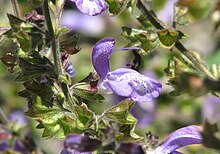|
Salvia forskaehlei
Salvia forskaehlei, synonym Salvia forskohlei, is a flowering plant in the family Lamiaceae native to Bulgaria and Turkey.[1] The spelling Salvia forsskaolei is also used.[2] It is a herbaceous perennial plant. It grows up to 6,000 ft (1800 m) elevation in broad-leaved and coniferous forests, meadows, and on steep banks. It was named after Finnish explorer and naturalist Peter Forsskål, a student of Carl Linnaeus who collected plants in southwest Arabia in the 18th century. DescriptionThe plant grows into large basal clumps 2 ft (0.6 m) tall and wide, with hairy leaves that are parsley-green in spring, turning dark green in summer. The flower whorls are few and widely spaced, with the flower a showy two-lipped violet-blue color that has white streaks with yellow markings on the lower lip.[3] TaxonomyThe species was first described by Carl Linnaeus in his 1767 work Mantissa Plantarum where he spelt the epithet forskaehlei.[4] In the 12th edition of Systema Naturae, also published in 1767, Linnaeus spelt the epithet forskohlei,[5] although referring back to Mantissa Plantarum.[6]: 67 Plants of the World Online treats S. forskohlei as a synonym of S. forskaehlei.[1] NotesWikimedia Commons has media related to Salvia forskaehlei.
|
||||||||||||||||||||||||||||||||
